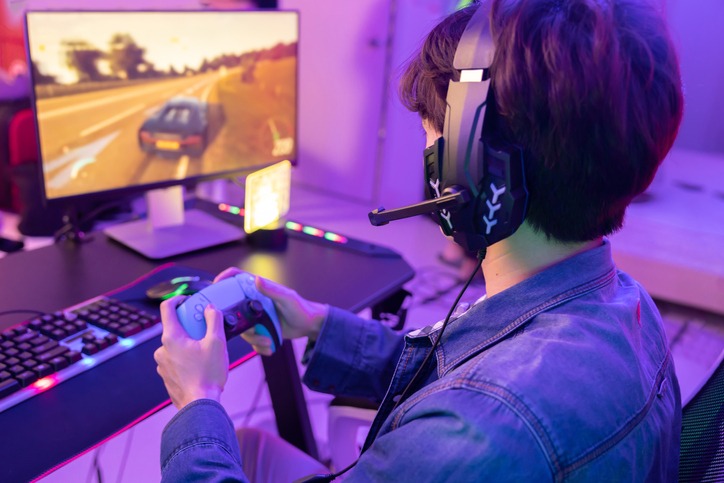The world of video games is dynamic, and animation stands as an essential element that gives life to every frame, character, and storyline. It transforms code and pixels into vivid, immersive worlds that captivate the imaginations of players. Animation has not just been part of the journey, looking back at the evolution of video games, but has also often driven the industry forward. From the basic sprites of the early arcade games to the hyper-realistic characters in the latest releases, the progression of animation technology reflects the broader evolution of gaming itself.
In this article, we are going to tackle the role of animation in shaping the gaming industry. We will explore how animation has transitioned from a functional aspect to a central component in game design, influencing everything from gameplay mechanics to storytelling. Understanding this evolution offers insight not just into the technical advancements of the industry but also into the changing expectations and experiences of gamers worldwide. With this, let us explore the vibrant history and impact of animation in video games.
The Early Days of Video Game Animation
![]()
The journey of animation in video games dates back to the industry’s infancy, where creativity often sprang from technological limitations. In these early days, video game animation was a far cry from what we see today, but it laid the foundational stones for the future of gaming.
Beginnings with Basic Graphics
The era of the 1970s and early 1980s was marked by games like “Pong” and “Space Invaders.” These games featured extremely basic 2D graphics. Animation was rudimentary, consisting of simple movements and blinking lights. The hardware limitations of the time meant that developers had to be creative with their design choices. They used minimalistic graphics that could still tell a story or create an engaging experience.
The Rise of Pixel Art and Sprites
As technology progressed, so did the complexity of animations. The introduction of pixel art and sprites in games like “Pac-Man” and “Donkey Kong” represented a significant leap. Sprites were 2D bitmap graphics that could be moved independently across a static background. This allowed for more fluid and varied animations, albeit still within the confines of the limited pixel count and color palettes.
The Influence of Arcade Games
Arcade games were instrumental in pushing the boundaries of what could be achieved with animation at the time. They often had better hardware than home consoles, which allowed for more advanced graphics and smoother animations. The success of these arcade games demonstrated the potential of animation to enhance gameplay and user experience, encouraging further innovation in the field.
Early Home Consoles and Evolving Animation
The introduction of home consoles like the Atari 2600 brought video games and their animations into living rooms. While the graphics were still basic compared to arcade machines, they began a trend of rapid development in home gaming. This era saw the introduction of scrolling backgrounds and more detailed character animations, setting the stage for more complex storytelling in games.
Technical Challenges and Creative Solutions
Early game developers faced significant technical challenges, such as limited memory and processing power. These constraints, however, fueled creativity, leading to iconic designs and animation techniques that are still celebrated today. The simplicity of these early animations required a strong focus on gameplay to keep players engaged, laying the groundwork for the game design philosophies of today.
The early days of video game animation were marked by groundbreaking creativity within the confines of technological limitations. These foundational years set the stage for the incredible advancements in animation that would follow, playing a crucial role in the evolution of the gaming industry.
The 3D Revolution in Gaming

The 1990s marked a significant turning point in the history of video game animation with the advent of the 3D revolution. This era ushered in a new dimension of gaming, profoundly altering the landscape of game design and animation.
Transition from 2D to 3D Animation
The shift from 2D sprite-based graphics to 3D polygonal models was monumental. It represented not just a technical progression but a fundamental change in how games were conceived and experienced. Early titles like “Wolfenstein 3D” and “Doom” began experimenting with 3D-like environments, setting the stage for more complex 3D worlds.
Technological Breakthroughs
This revolution was fueled by significant advancements in computer graphics technology. The introduction of more powerful graphics processing units (GPUs) allowed developers to render more complex geometries and textures. The development of dedicated 3D graphics software and engines played a crucial role in this transition, enabling developers to create more detailed and immersive environments.
Impact on Game Design and Gameplay
The move to 3D animation fundamentally changed the game design. It allowed for more realistic environments, complex character models, and a new level of interactivity in game worlds. This transition also introduced new gameplay mechanics, such as camera control and character movement in a three-dimensional space, significantly enhancing player immersion.
Milestone Games in 3D Animation
Games like “Super Mario 64” and “The Legend of Zelda: Ocarina of Time” on the Nintendo 64 were pivotal in showcasing the potential of 3D animation in games. They set high standards for character animation and environmental design. “Tomb Raider” and “Half-Life” further pushed the boundaries, offering more intricate animations and storytelling possibilities.
Challenges of the 3D Era
Despite the excitement, the shift to 3D brought challenges. Early 3D games often struggled with clunky controls, camera issues, and less refined animations due to the limitations of the technology at the time. Developers had to learn and adapt to new tools and techniques, which initially led to a learning curve in both design and execution.
Establishment of 3D as the New Standard
By the late 1990s and early 2000s, 3D animation had become the standard in the gaming industry. The level of realism and depth it brought to games was unparalleled, leading to new genres and gaming experiences.
The 3D revolution in gaming marked a significant evolution in video game animation. It not only changed the way games looked but also how they were played and experienced. This era laid the groundwork for the incredibly immersive and realistic games we see today, showcasing the power of animation in transforming the gaming medium.
The Impact of Motion Capture Technology
The integration of motion capture technology into video game development marked another significant milestone in the evolution of animation in the gaming industry. This technology brought a new level of realism and sophistication to character animation.
Motion capture (mocap) technology involves recording the movement of people or objects and translating it into digital models. This technology, initially used in film and animation, found its way into video game development in the late 1990s and early 2000s. It enabled game developers to create more realistic and fluid character movements, making the in-game characters move and behave more like real humans or animals.
One of the key impacts of motion capture is the heightened level of realism it brings to character animations. The subtleties of human movement and facial expressions captured through mocap lend a degree of authenticity that is hard to achieve with traditional animation techniques. This realism is not just visual but also emotional, allowing players to connect more deeply with the characters and the story.
Games like “Uncharted,” “The Last of Us,” and the “Tomb Raider” reboot series have utilized motion capture to great effect, offering cinematic-quality storytelling and character development. Sports games, such as the “FIFA” series, have also heavily relied on mocap to replicate the movements of real-life athletes accurately, enhancing the gameplay experience.
As the technology continues to advance, it’s likely that motion capture will become more accessible and widely used in the industry. Innovations such as markerless motion capture and real-time rendering are opening new possibilities for smaller studios and independent developers.
Animation and Storytelling in Games

In the realm of video games, animation serves as a powerful storytelling tool, bridging the gap between narrative and player experience. As the industry has evolved, the role of animation in conveying storylines, character development, and emotional depth has become increasingly significant.
Animation as a Narrative Device
Animation in video games is not just about creating visually appealing characters and environments; it’s an essential medium for storytelling. The way a character moves, expresses emotions, or interacts with the world, can tell a story in itself, adding depth and layers to the narrative.
Subtle nuances, like the way a character glances at an object or reacts to an event, can convey a wealth of information and emotion, enriching the storytelling without the need for dialogue or exposition.
Evolution of Cutscenes
Cutscenes have been a traditional method of storytelling in video games, and animation plays a pivotal role in these cinematic interludes. Early games had basic, static cutscenes, but advancements in animation have enabled fully animated, dynamic sequences that enhance the narrative. These animated scenes can create dramatic, movie-like experiences within the game, blurring the lines between gameplay and cinematic storytelling.
Interactive Storytelling and Player Choice
In modern gaming, animation has become integral to interactive storytelling, where player decisions influence the narrative. The animation must adapt to various scenarios and outcomes, reflecting the player’s choices in real time. This dynamic form of storytelling, supported by advanced animation, allows for a more personalized and immersive gaming experience where players feel genuinely connected to the game’s world and characters.
Emotive Character Animation
The advancement of facial animation technology in games has allowed for more expressive and emotive characters. This is crucial in conveying complex emotions and building connections between the player and the characters. Games like “Detroit: Become Human” and “Mass Effect” series have utilized advanced facial animation to great effect, making characters more lifelike and emotionally resonant.
Environmental Storytelling
Animation also plays a key role in environmental storytelling, where the setting itself tells a story. The way elements in the environment move and change can provide context, background information, and mood, contributing to the overall narrative. This can include everything from the grand, sweeping animations of changing landscapes to the subtle movements of objects that hint at a location’s history or secrets.
Challenges and Opportunities
Balancing gameplay mechanics with storytelling through animation can be challenging. Animators must ensure that the animations are not only visually impressive but also serve the game’s narrative and gameplay. As technology advances, there is a growing opportunity to use animation in more innovative ways to tell stories, creating experiences that are unique to the interactive nature of video games.
Animation is a fundamental element in the storytelling toolkit of modern video games. It brings narratives to life, allowing players to engage with the game’s world and characters on a deeper level. As technology continues to evolve, the potential for animation to enhance storytelling in games is boundless.
The Current State and Trends in Game Animation

The landscape of game animation is continually evolving, driven by technological advancements and creative innovations. As we look at the current state of game animation, several trends and practices stand out, shaping the future of this dynamic field.
- Hyper-Realism and Photorealistic Graphics: One of the most notable trends in modern game animation is the push towards hyper-realism. Games are increasingly featuring photorealistic graphics with detailed textures, lifelike character models, and realistic environmental effects. This trend is driven by advancements in graphics processing technology, allowing for higher-resolution textures, more complex lighting effects, and more detailed character animations.
- Stylization and Artistic Expression: While realism is a dominant trend, there’s also a strong movement towards stylization and artistic expression in-game animation. Many developers are embracing unique art styles to distinguish their games, ranging from hand-drawn 2D animations to stylized 3D models. Games like “Cuphead,” with its 1930s cartoon style, and “Hades,” with its distinct art design, showcase how animation can be used to create a unique visual identity.
- Procedural Animation and AI-Driven Systems: Procedural animation, where movements are generated algorithmically rather than being pre-animated, is becoming more prevalent. This approach allows for more dynamic and responsive animations that adapt to gameplay. AI-driven animation systems are also emerging, capable of creating more natural and varied character movements without extensive manual input from animators.
- Motion Capture’s Evolving Role: Motion capture continues to be a significant trend in game animation, particularly for narrative-driven games where realistic character performances are crucial. The technology is becoming more accessible to smaller studios, enabling them to achieve high-quality animations that were once the domain of big-budget projects.
- Integration with Virtual and Augmented Reality: As virtual reality (VR) and augmented reality (AR) technologies mature, game animation is adapting to these new mediums. Animation for VR and AR requires a different approach, focusing on 360-degree immersion and interaction. The challenge for animators is to create movements and behaviors that feel natural and convincing in a fully interactive environment.
- Emphasis on Diverse Character Representation: There is a growing emphasis on diversity and representation in game characters. Animators and designers are working to create characters that reflect a wider range of experiences, cultures, and identities. This trend is not only about visual representation but also about animating these characters in ways that are authentic and respectful.
Looking forward, we can expect continuous innovation in game animation. Technologies like ray tracing and advancements in AI are set to further revolutionize how games are animated and played. The future of game animation will likely see even more blending of artistic styles, innovative use of technology, and a stronger focus on storytelling and immersive experiences.
While animation adds depth and realism to the gaming world, developers also face the challenge of ensuring these games run smoothly across all devices. What Techniques Are Used to Optimize Game Performance on Low-End Hardware? dives into the strategies and innovations that enable complex animations and graphics to perform seamlessly, even on less powerful hardware, ensuring an immersive gaming experience for all players.
Conclusion
Animation has played a fundamental role in the evolution of video games, transforming them from simple pixelated forms to complex, immersive worlds. From the early days of 2D sprites to the latest advancements in hyper-realism and procedural animation, the journey of game animation mirrors the broader growth of the gaming industry.
As technology continues to advance, we can expect to see even more innovative and captivating animations that will further enrich our gaming experiences. The future of game animation holds endless possibilities, promising to continue its vital role in shaping the world of video games and bringing digital worlds to life for players around the globe.

